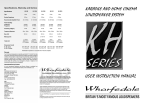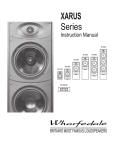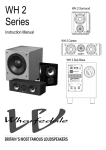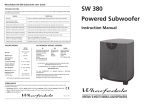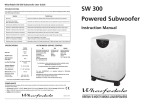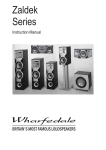Download Evolution EVO20 Instruction manual
Transcript
Pacific Evolution Series Instruction Manual BRITAIN'S MOST FAMOUS LOUDSPEAKERS Wharfedale Pacific Evolution Series Installation and User Guide Introduction DO NOT connect loudspeaker terminals to the mains supply. The Wharfedale Pacific Evolution Series is a range of versatile loudspeakers using advanced materials and the latest precision drivers. Pacific Evolution 8 and 10 are small stand mounting loudspeakers, The Pacific Evolution 20, 30 and 40 are floor-standing models. The Pacific Evolution Centre and DFS-20 are dedicated centre and rear surround units for Home Theatre applications. To complement your system, choose one of our Powercube powered subwoofers for the perfect Home Cinema experience. Thank you for purchasing Wharfedale. We hope your loudspeakers will give you rewarding listening for many years . Ensure that all loudspeakers in the system are correctly wired and are in phase. Please read these instructions carefully before installing your Wharfedale loudspeakers. Before making connections to any part of your sound system make sure the amplifier and all connected sources are switched off. When you switch on your system or change sources, set the volume control to minimum and turn up the level gradually. DO NOT use your amplifier at full volume. The position of the Volume Control is NOT a reliable guide as to the maximum volume level or capabilities of your sound system. Playing the system with extreme high settings of volume and tone controls will result in distorted sound and may damage the amplifier and loudspeakers. DO NOT subject your loudspeakers to excessive cold, heat, humidity or sunlight. WARNING: To reduce the risk of fire or electrical shock do not expose this product to rain or moisture. The product must not be exposed to dripping and splashing and no object filled with liquids such as a vase of flowers should be placed on the product. No naked flame sources - such as candles - must be placed on the product. DO NOT place heavy objects on top of loudspeaker cabinets. NEVER let anyone, especially children push anything into holes, slots or other opening in the case. If you wish to play your loudspeakers with their grilles removed be careful to protect the drive units from children and pets. DO NOT use makeshift stands. Always fit a manufacturer's approved stand according to the instructions and using the fixings provided. Your dealer will advise you. DO NOT attempt to dismantle the loudspeaker. There are no user serviceable parts inside and you will invalidate the warranty. Preliminaries Unpacking the Speakers Carefully remove each loudspeaker from its packing carton. Be especially careful when removing the polythene bag. DO NOT attempt to lift the loudspeaker by the polythene bag. Retain the packing for future use. If you decide to dispose of the packing, please do so safely. Now tighten the nut and cap. The illustration shows the completed assembly. Fitting the Plinth and Spikes (Pacific Evolution 20, 30, 40) Carefully invert each loudspeaker. Protect the top surface from scratches or damage when the loudspeaker is in the inverted position. Remove the plinth from the packing and screw it firmly to the pre-drilled loudspeaker base using the screws provided. Each loudspeaker is provided with a pair of short spikes and a pair of long spikes. Prepare the spikes as shown and screw the short spikes into the threads at the front of the plinth. FRONT The rear spikes should now be adjusted. Loosen the nut and cap and screw the spikes in or out so that the speakers are stable. The top surfaces of each loudspeaker should be level and the same height above the floor. Stands and Brackets The Pacific Evolution 8 and 10 are intended primarily for stand mounting, though they can be mounted on wall brackets or even on sturdy shelves. The quality of loudspeaker stands makes a considerable difference to the performance of your loudspeakers so do not use flimsy inferior products. Pacific Evolution Centre Channel Loudspeaker A set of self adhesive pads is provided. Peel off the backing material and fix a pad close to each corner of the bottom surface of the loudspeaker. BACK Screw the long spikes into the top caps at the rear of the plinth. Return the loudspeaker to its normal position taking care not to cause damage with the spikes. When moving speakers, be careful not to let the spikes pierce objects or cables which may be concealed under the carpet. Never drag loudspeakers. If you cannot lift them easily, get someone to assist you. Pacific Evolution DFS-20 Surround Loudspeaker Four self adhesive spacers are provided with each unit. Attach one close to each rear corner of the cabinet. This speaker is designed primarily for wall mounting - please see the separate section on this topic. Connections and Terminals Choosing and Preparing Cables Specialist audio cable usually offers better performance than general purpose 'bell' or 'zip' wire. Choose a cable of suitable diameter - cable that is too thin will limit the dynamics of the sound and may impair the bass response. Audio cable is polarised, with two cores of different colours, or often a raised rib ot coloured tracer in the case of twin cable. 10mm 40mm Split the twin cores to a depth of about 40mm. Caefully strip the insulation from each end, leaving about 10mm of bare wire. If the cable is stranded, lightly twist to gather any loose strands. Crossover Networks Pacific Evolution front and centre loudspeakers use a specially designed bi-wireable crossover panel with four terminal binding posts. Please follow the drawing carefully to see the correct orientation of the loudspeaker terminals. The upper terminals connect to the treble unit, the lower pair to the bass unit. As supplied, the treble terminal pair is connected to the bass terminal pair via removable metal straps. These should be left in place for standard installations. The Pacific Evolution DFS-20 uses a conventional twin terminal crossover panel. Pacific Evolution Front and Centre Channel Crossover Network and Binding Straps Pacific Evolution DFS-20 Crossover Network Connecting Loudspeaker Terminals Unscrew the terminal. Thread the bared end of each cable through the hole in the bottom of the terminal post. Ensure that there are no loose strands which may touch adjacent terminals. Retighten the terminal securely. The drawing on the right illustrates the method. NOTE: When connecting loudspeakers, the cables to left and right channels should be of equal length, regardless of the distance of the speakers from the amplifier. This applies to front and rear channels. Connecting Your Loudspeakers Standard Connections Using separate cables for treble and bass units in a Bi-Wiring configuration reduces intermodulation effects and improves headroom and clarity. To bi-wire, you will need to install two lengths of twin core cable between the amplifier and each loudspeaker. Unscrew each terminal a few turns and remove the metal straps. Connect the cables between the amplifier and the loudspeakers as indicated above and re-tighten all the terminals securely. Note: Some amplifiers have two pairs of output terminals to facilitate bi-wiring but this is not essential. The advantages of bi-wiring are fully retained if your amplifier has only one pair of output terminals per channel (as in the illustration). Bi-Amplifying (Bi-Amping) By connecting each loudspeaker drive unit to its own dedicated amplifier the advantages of Bi-Wiring can be extended. If you own two identical stereo power amplifiers, your Pacific Evolution speakers may be Bi-Amped. For further details please consult your dealer. Choose a suitable length of twin core speaker cable for each channel, and prepare the ends as described above. Unscrew each terminal a few turns but leave the straps in place. Connect the red, positive (+) terminal of the Left loudspeaker to the corresponding red, positive (+) amplifier terminal. Connect the black, negative (-) terminals similarly. Tighten the terminals securely. Repeat this procedure for the Right Channel. Centre Channel and Surround Loudspeaker Connections The Pacific Evolution Centre and DFS Surround loudspeakers are intended for use specifically with Audio Visual equipment having Centre and Rear loudspeaker outputs. Connect these loudspeakers as shown, again observing polarity. The Centre channel speaker may be connected as shown, or bi-wired. You may connect the loudspeakers using either the upper or the lower pair of terminals. Bi-Wiring Connections Positioning Your Loudspeakers Conventional Loudspeakers Pacific Evolution 20, 30 and 40 are designed to be floor standing. We suggest you position them at least 200 mm from the rear walls and 700 mm from the side walls, facing slightly inwards. The Pacific Evolution 8 and 10 should ideally be stand or wall mounted though they may be placed on a rigid shelf. The bass extension will improve if these speakers are operated closer to the rear walls. A useful rule of thumb is that the listener should be as far from the loudspeakers as they are from each other. If the loudspeakers are placed too close to the walls the bass will increase but may be boomy and indistinct. If the loudspeakers are placed further away from the walls, the inward angle may be increased by up to 40%, although this may restrict the width of the optimum listening position. The speakers should ideally be positioned so that the treble units are roughly at ear level to a seated listener. As personal taste plays a large role, experiment with different configurations and play a wide range of programmes before finalising the position of your speakers. Pacific Evolution Centre Loudspeaker This loudspeaker should be positioned centrally between the loudspeakers close to the television and mounted either above or below the screen. The loudspeaker should be located on a stable flat surface to avoid any danger of the cabinet moving when it is vibrated by high sound levels. If you mount the unit on top of the television, move it forward so that the front grilles are level with or slightly in front of the screen. This will reduce reflections from the screen and the top of the cabinet. Although you can place the centre channel loudspeaker under the TV monitor, this should always be regarded as second best. The preferred position is always above the monitor, as shown. The Pacific Evolution DFS-20 Surround Loudspeaker Connect the cable to the speaker. The speaker should ideally be sited 600 mm-1.5 metres above the listening position and 2.5-3.5 metres apart, central to the listener and behind the listening position, preferably on a rear wall. If the listening position is some distance from a rear wall, the loudspeakers may be mounted on opposite side walls but always behind the listening position. Ensure that the wall is sound and can support the product. Drill two 5mm holes in the wall 160mm apart and horizontally aligned. Fix a suitable No 8 round head screw firmly into each hole using appropriate wall plugs. Leave a stub of 5mm protruding from the wall. Align the holes in the mounting brackets over the screw heads and carefully lower the unit onto the screws. The speaker should now be securely attached with the spacers resting against the wall. Now connect the speakers to the amplifier. Note: For those unable to wall mount the DFS-20, you should consider using a suitable pair of floor stands of appropriate height. Consult your dealer for advice. Front and Effects Channels channels are reproduced at equal loudness. The front loudspeakers are placed on either side of the television screen, 2 to 3 metres apart. The speakers should be angled slightly so they are aimed towards the listeners. On some programme material the surround channel may seem lower than the front. Do not readjust this level. You may, however, need to adjust the subwoofer output level. Avoid setting too high a level or you will swamp the sound with bass which be tiring to listen to and may limit the subwoofer’s ability to respond to large bass transients. You should also set a sensible level going into the subwoofer from the AV processor. As the rear surround channels are the ‘effects’ channels the reproduced sound should be as room filling as possible. We recommend placing the speakers in a high position, behind the listener’s head and angled towards the listener. If the rear wall is more than 1metre behind the listening seat, position the units on the side walls. If the walls are a long way from the listening seat, consider stand mounting the loudspeakers. Most of the dialogue comes from the centre loudspeaker. Speech should appear to originate from the actors’ mouths. Operating height is important. Ideally the front and centre channel speakers should be at the same height . For this reason the centre channel speaker is best operated on top of the television monitor. The front faces of the centre and surround loudspeakers should also be in line as far as possible. Subwoofer As the ear is unable to detect the direction from which deep bass originates, this allows you freedom to position the unit. Varying the distance from the wall alters the bass. Placing the subwoofer across a corner boosts the bass but may impair clarity. The performance of Home Theatre systems can often be enhanced by using a pair of subwoofers. Setting Loudspeaker Sizes Many digital AV Processors require you to specify the size of speakers in all channels. These are usually ‘Large’ or ‘Small’. Always choose 'Small' for the Surround channels and Centre channel whether you are using a subwoofer or not. If you are not using a subwoofer: Set the Front Speakers to ‘Large’. Set the ‘Subwoofer’ option on the processor to 'Off' or ‘No'. The Front channels will now receive all the system bass. If you are using a subwoofer: When set to ‘Small’ all the system bass will go into the subwoofer. If you choose ‘Large’ the Front channel bass will be reproduced from the Front speakers. Bookshelf speakers should be set to ‘Small’, large floor standing units may be set to ‘Large’. Setting Levels Once the loudspeaker settings have been finalised, put the AV amplifier into its “Test” mode (see instructions supplied with your processor). Adjust the level of each channel in turn until all Delay Settings Many AV processors feature delay settings. The purpose of delay is to enable surround and dialogue information to arrive at the listener’s ears at the same time as the Front channels, even when the listening seat is in a non-ideal position. Rear Delay: If the listening position is equidistant from the Front and Rear speakers, a low delay setting should be set. The closer the listener is to the Rear speakers the higher should be the delay setting used, Centre Delay: If the Centre speaker is level with (or slightly behind) the Front speakers, set the delay to zero. If the Centre speaker is forward of the Front speakers, increase the delay. LFE In the cinema the Low Frequency Effects channel is an extra bass channel with its own subwoofer and not a regular subwoofer channel. In domestic systems the LFE channel typically feeds into the subwoofer. Where no subwoofer is used, the LFE signal is combined with Front Channel information. When you set the LFE level at your AV processor, use care as the powerful low frequencies can overload domestic loudspeakers. If you hear popping or thumping noises coming from the front loudspeakers or subwoofer, immediately turn the AV Processor's volume level down and then back off the LFE level. This should cure the problem. If it does not, back off the volume level at the subwoofer (if you are using one) until the problem disappears. Please read the relevant sections of your AV amplifier manual and familiarise yourself with the various issues. If you are unsure, consult your dealer for help. Phase A Home Theatre system should have a precise front stage, a diffuse rear stage and good localisation of dialogue. If the colours on the loudspeaker terminals do not correspond with those on the amplifier, the sound will appear poorly focussed or ‘out of phase’. For this reason it is essential that the speakers are connected according to the wiring diagrams in this manual. The terms of your guarantee may vary in different countries but in all cases the guarantee excludes: Care And Maintenance If you play the speakers with the grilles off exercise great care. NEVER touch the drive units which are easily damaged. The loudspeaker cabinets can be cleaned with a damp cloth or with a spray furniture polish and a soft cloth. Apply the spray sparingly to the cloth and then polish the cabinet. Never apply spray directly to the cabinet. All damage caused through accident, misuse, wear and tear, neglect, incorrect installation, adjustment or repair by unauthorised personnel. Liability for damage or loss occurring in transit to or from the purchaser. Wharfedale will not be liable for any consequential damage, loss or injury, arising from or in conjunction with this equipment. Conclusion Guarantee & Service In the unlikely even that your unit develops a fault you should return it to your Wharfedale dealer using the original packing to ensure safe shipping. The Pacific Evolution series is just one of an extensive and world-acclaimed range from Wharfedale, one of the world’s oldest and most distinguished loudspeaker manufacturers. Thank you for purchasing Wharfedale; we hope this product brings you many years of reliable service and good music. Troubleshooting If your system appears not to be working as well as you expect, the following notes may be of some help. Please read this manual together with all the manuals concerning the rest of your system. Before investigating the cause of a problem, always switch off the system at the mains. If, having attempted to resolve the problem, the trouble still persists, consult your dealer for assistance. Please bear in mind that Home Theatre systems can be quite complex and there is often a variety of factors involved. Do NOT try to remove any covers on the product or attempt to dismantle it in any way. There are no user serviceable parts inside and you will invalidate any warranty. Symptom Possible Cause No Sound System not switched on Wrong source selected Sound lacks bass content Bass reproduction muddy or indistinct Loudspeakers wired incorrectly Front speakers set to ‘Small’ with no subwoofer connected Excessive bass distortion at low volume levels Bass level set too high LFE level set too high Excessive or distorted bass at high volume levels System level set too high Front loudspeakers or subwoofer too close to room corners Distorted or rattling sounds at high volume levels System level set too high Objects placed on Front loudspeakers or subwoofer Popping sounds or thumps from Front speakers or subwoofer System level set too high LFE level set too high: Subwoofer level set too high Indistinct sound Poor localisation of effects One or more loudspeakers is out of phase (See the relevant pages of this manual for the correct connection procedure) Television picture is distorted or there is colour distortion Front loudspeakers or subwoofer too close to the TV. (Switch off the system and TV. Move loudspeaker away. Leave 15 mins. Switch on again) Further help and advice A wide range of AV and audio topics can be found at the Wharfedale web site. www.wharfedale.co.uk Home Theatre is discussed in depth at the Dolby Laboratories web site. www.dolby.com The Digital Theater Systems web site is also full of interest and worth a visit. www.dtsonline.com Specifications and Service Pacific Evolution 8 Pacific Evolution 10 Pacific Evolution 20 Pacific Evolution 30 Pacific Evolution 40 Pacific Evolution Centre Pacific Evolution DFS-20 6 Ohms 6 Ohms 6 Ohms 6 Ohms 6 Ohms 8 Ohms 6 Ohms 25-125 Watts 25 -125 Watts 25 -150 Watts 30 -200 Watts 30 -200 Watts 25 - 100 Watts 25 - 200 Watts Sensitivity (1W@1m) 87 dB 87 dB 87 dB 89 dB 89 dB 89 dB 90 dB Frequency Response 50 - 20 kHz 40 - 20 kHz 35 - 20 kHz 35 - 20 kHz 30 - 20 kHz 80 - 20 kHz 70 - 20 kHz 130 mm 170 mm 170 mm 170 mm 170 mm 2 x 130 mm 2 x 125 mm 25mm Textile 2 x 25mm Textile 180 x 422 x 296 7.1 x 16.6 x 11.6 365 x 352 x 160 14.4 x 13.9 x 6.3 Nominal Impedance Recommended Amplifier Bass Unit 170 mm Bass-Mid 170 mm Bass-Mid Midrange Unit Treble Unit Dimensions Overall H x W x D mm H x W x D inches 25mm Textile 25mm Textile 25mm Textile 25mm Textile 330 x 185 x 335 13.0 x 7.3 x 13.2 380 x 227 x 343 15.0 x 8.9 x 13.5 850 x 227 x 343 33.5 x 8.9 x 13.5 25mm Textile 880 x 229 x 403 1070 x 229 x 403 34.6 x 9.0 x 15.9 42.1 x 9.0 x 15.9 Wharfedale Pacific speakers are compatible with 4 and 8 Ohm amplifiers Authorised Wharfedale Service Centres UK Wharfedale International Ltd. IAG House, Sovereign Court, Ermine Business Park, Huntingdon, Cambs PE29 6XU, England. Tel:+44 (0)1480 447700 Fax: +44 (0)1480 43176 USA IAG America, Inc. 15 Walpole Park South Walpole MA 02081 Tel: +1 508 850 3950 CANADA Korbon Trading Ltd 6800 Kitimat Road Units 19-20 Mississauga Ontario Tel: +1 905 567 1920 For information on other authorised service centres worldwide contact Wharfedale International in the U.K. A worldwide distributor list is available on the Wharfedale website: www.wharfedale.co.uk The name ‘WHARFEDALE' is a registered trademark of Wharfedale International Limited. Wharfedale has a policy of continuous product development and reserves the right to change specification without notice. Wharfedale is a member of the International Audio Group. 1932 Loudspeaker Manufacturers since 1932 In 1932, when Gilbert Briggs founded the Wharfedale Wireless Works, his company was at the leading edge of an exciting new technology which was dedicated to bringing the pleasure of music and entertainment to a wide range of people. As the technology advanced Wharfedale gave many music lovers their first taste of High Fidelity, mounting a series of live sound demonstrations which excited the audio world and heralded the era of the modern hi-fi loudspeaker. Today Wharfedale still takes the same uncompromising approach to the design and manufacture of every loudspeaker system, using high quality components and state-of-the-art testing to ensure consistently high performance. And that means that you can continue to count on the quality of all Wharfedale products.






